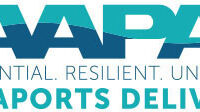‘Seriously, Where Is My Stuff?’

Eric Topp learned an important lesson doing load planning and loading break-bulk ships at the Port of Oakland when he began his career in transportation and logistics: There’s often a difference between what someone at a higher level tells you is happening and what’s actually taking place on the ground.
Today, as head of worldwide solutions and business development for transportation and logistics at Amazon Web Services (AWS), Topp is working with the Port of Long Beach (POLB) on an ambitious project aimed at filling the information black holes that snarl ports and leave cargo owners wondering where their shipping containers are and when they’ll arrive.
Spearheading the project, dubbed the Supply Chain Information Highway, is Noel Hacegaba, POLB’s executive deputy director. His vision is to create a national digital platform that aggregates data from all participants in the supply chain and converts it into actionable information that can be easily and securely shared.
“This is our attempt to help close one of the most glaring gaps in the supply chain today,” Hacegaba said. “We know the lack of visibility has existed for quite some time, but it’s been magnified by the pandemic. The lack of visibility is caused by the lack of information sharing, and the friction, if you will, of data going from one mode to the next.”
Since launching the project in December 2021, Hacegaba has signed up five other port authorities – Oakland, Utah Inland Port Authority, the Northwest Seaport Alliance (Seattle and Tacoma), Miami and the South Carolina Ports Authority – and expects “a few more” ports to join by the end of 2022.
In the first phase of the project, two shipping lines, multiple shippers and rail partners are sharing data on container movement in and out of the Long Beach Container Terminal. Phase Two will involve expanding the effort to all six of the port’s container terminals and adding Oakland to the data-sharing platform while continuing to sign up more ports and partners willing to share their data.
Ultimately, the highway will be effective only to the extent that ports and supply chain partners climb aboard and share information – one reason POLB is making the new data platform available for free to authorized users. But even in its infancy, the impact of the Supply Chain Information Highway already is being felt, said Jack Hedge, executive director of the Utah Inland Port Authority.
“What we’re starting to see happen is customers whose boxes used to be stuck on the terminal (on the West Coast) for weeks, if not months at a time, are now able to get information about that container being stuck, match it up with some of the new service offerings that we have bringing cargo inland more rapidly, more efficiently, more fluidly, and take advantage of that service,” Hedge said. “Nine months ago, that would have been really hard to do.”
‘Seriously, Where Is My Stuff?’
The information highway had its origins in an initiative launched by Hacegaba a few years before the pandemic to get a better handle on port stakeholders’ needs. In early 2021, he enlisted AWS, which led a “working-backward” exercise that started with reaching out to the port’s customers to identify their pain points so POLB could then develop a strategy to address them.
The common thread that emerged: Frustration was mounting over lack of visibility throughout the supply chain that led to ineffective planning and scheduling and inefficient use of trucks, railcars and other equipment. Access to better data was critical to getting cargo flowing better.
“When we ran through the working-backward process, the interim project name was SWIMS, the acronym for ‘Seriously, Where Is My Stuff?’” Topp said. “The premise was everyone was calling the port trying to find out where their cargo was, and that basically led to the identification of the issue of having a common platform to bring all of this data into one location.”
With ease of use and data security as key objectives, Long Beach turned to UNCOMN, an expert in designing complex data management systems and protecting transportation and logistics data for the most security-conscious client imaginable – the U.S. Department of Defense. The project tapped AWS for its Amazon Simple Storage Service (Amazon S3), a scalable cloud-based storage service that provides authorized users with uninterrupted, effortless and secure storage on the cloud for all of their data, Topp said.
The system designed and implemented by UNCOMN takes data from all available sources in any format and converts it into data files that can be accessed by authorized partners of POLB in a standard format easily consumable by their existing systems, thus addressing a growing information divide separating supply chain participants, said Nick Powers, UNCOMN’s chief operating officer.
“When you pull into a port there’s a million things that happen, whether it be the ocean carrier sending data out, or the terminal operator sending data out, or the rail and the trucks sending data out,” Powers said. “To turn that data into information you can use takes a lot of time, effort and money, and as a result, there’s a have-and-have-not situation that’s evolved over time.”
While the large trucking aggregators have advanced systems that can plug into the data using an application programming interface (API), the majority of trucking companies in America are mom-and-pops with under five trucks, so the data platform is designed to let those users and small businesses that might route only two or three containers a year access the same data using an Excel spreadsheet.
AWS’s Topp was reminded of the need for POLB’s information highway when he heard from small trucking companies at a meeting of the Southern California Supply Chain Group while attending the Trans-Pacific Maritime (TPM) conference in Long Beach in February.
“The guys that own 10 or fewer trucks were saying, ‘Hey we’re ready to move stuff, the problem is the systems don’t work for us. We’re a mom-and-pop trying to figure out how to pick up a load, and we get an order and then we end up sitting around waiting forever to get the confirmation to then come pick it up.’”
Tracking the ‘Muscle Movements’
Another barrier the project had to overcome – reluctance to share data out of fear it could be used by competitors – led POLB to limit the ask to what Powers calls the “muscle movements” of the supply chain related to containers, including discreet events such as “vessel arrival, vessel unload, vessel load, load to rail, offload rail, load to truck, offload truck, truck in and out gate, rail in and out gate.”
“I’m not getting into, say, how the fingers are moving, I’m getting into how the arms are moving,” Powers said. “There is proprietary and sensitive data contained in the fingers. This is the data that no one wants to share, and no one wants us to share. So we focus on a higher level and that compromise is bringing in willing participants.”
For example, the information highway is making data available on when container ships at anchor off POLB are scheduled to arrive and depart from a terminal. The port struck an agreement with Jacobsen Pilot Service to provide the data in real time.
“There’s a gap in visibility that only Jacobsen can fill because all of these ships are at anchor waiting in a queue, and the folks that manage that queue is Jacobsen,” Powers said. Being able to share accurate terminal arrival times compresses the information gap and gives upstream supply chain participants the intelligence on container events they need to plan and prepare, shared Powers. In the case of truckers, for example, that might include being able to know when their customers’ containers will be ready for pickup and delivery.
Maximizing Other Tools
POLB’s Hacegaba views the Supply Chain Information Highway as an enabler for rather than a competitor of existing cargo visibility tools like Maersk’s TradeLens platform. In his analogy, those tools are “cars” that carry data and the highway is the common corridor they will travel on to make data accessible to participants throughout the supply chain. Each port that signs on is a new “on-ramp.”
“What we didn’t want to do was recreate or reinvent another cargo visibility tool,” Hacegaba said. “We were more interested in getting to true end-to-end visibility across the supply chain and, eventually, coast to coast. We don’t view all of the other tools as competition, in fact we view them as complementary. We view this highway as a way to help these other tools maximize their potential.”
UNCOMN’s Powers agrees.
“We believe we are going to enable all of the planning, scheduling and optimizing systems currently being used by the transportation industries and beneficial cargo owners (BCOs) to work better because we’re going to give them more access to data,” Powers said. “Most systems, in my opinion, are going to have (access to) about 60% to 70% of the data they need, and then the other 30% they’re guessing. If we can move that up to 85% to 90%, that is going to make things better.”
Complementing Port Initiatives
Port executives say the Supply Chain Information Highway also will complement ongoing initiatives to improve the flow of cargo in and out of their ports. Port of Oakland, for example, the next “on-ramp” to be added to the highway, is well on its way to completing a $30.6 million project – the Freight Intelligent Transportation System (FITS) – in partnership with the Alameda County Transportation Commission.
FITS will provide truck drivers with real-time information about anticipated turn times, availability of public truck parking at the port and display signs throughout the port advising drivers of traffic congestion and providing alternative routes. Digital infrastructure improvements that are part of the project, including fiber optic cable, cameras and RFID readers, will add to the container event data stream Oakland can supply to the information highway.
“FITS is a suite of technology initiatives that will improve the overall trucker experience at the Port of Oakland,” said Bryan Brandes, maritime director for the Port of Oakland. “The FITS program will enhance the Supply Chain Information Highway by aiding traffic management, security systems and roadway improvements.”
Utah Inland Port Authority has several projects underway that will be enhanced by access to the data supplied by the highway and in turn contribute data to it, according to Hedge. One is a pilot wireless system that will capture detailed data on container movements within the port and provide it in real time via the information highway to trucking companies, BCOs, shippers and other supply chain partners.
Said Hedge: “That starts to create data that is actionable, and feeding that into the information highway is just one of the ways that we’re participating and starting to see big benefits from that.”
Costs, Benefits for Ports
As part of POLB’s commitment to keep the new data platform a “freeway” rather than a toll road, creators of the Supply Chain Information Highway hope to find ways to make the project cost-neutral with grants and other sources of funding, and they are confident the return on investment will far outweigh the cost, especially after the volume of data feeding into the highway reaches critical mass as more ports, shippers, rail partners and BCOs sign on. That point could come sooner rather than later given the number of ports that have expressed interest in becoming the latest on-ramps.
In addition to the improved flow of cargo through the supply chain, the follow-on benefits of the highway are yet to be fully understood. Ports that provide enhanced supply chain visibility to their customers could well be repaid in higher cargo volumes, Powers predicts. POLB, he said, will share summary information from the POLB platform with state officials in California’s Transportation Agency (CALTRANS) to improve their ability to plan for infrastructure improvements and other public investments.
Sustainability efforts will get a boost, too: Hacegaba says the highway will likely contribute to a greener supply chain as better scheduling and planning enabled by access to real-time intelligence helps reduce traffic congestion at ports and the time drivers sit with engines idling as they wait to pick up containers.
“There are all of these things that come out of (the information highway project) – the second-, third-, and fourth-order effects,” Powers said. “I can’t even name all of them because it feels like every day a new one comes out of it, and as a result of the aggregation of all those benefits ports will see far more value than what it costs to stand the system up.”




